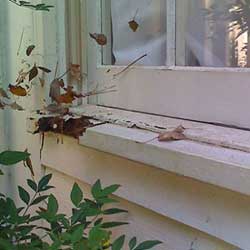 Wood windows need a lot of care and you probably don't realize how many windows your home has. My condo has 26 windows, fewer than my Victorian which was quite a bit larger, so you probably have more than you realize.
Wood windows need a lot of care and you probably don't realize how many windows your home has. My condo has 26 windows, fewer than my Victorian which was quite a bit larger, so you probably have more than you realize.
If you calculate even 20 minutes of maintenance per wood window each year, that equals 9 hours of maintenance each year just for windows. Most home owners don't realize how much work is involved in cleaning, sanding and painting windows and the work doesn't get done.
When you don't take good care of wood windows, you get wood rot like the window shown at right. If the damage is extensive, then you get to replace the window like was done here. Keep reading to learn how to take care of your windows.
Maintaining Your Windows
The biggest challenge to maintaining your windows is there aren't clues to remind you. When your floors get dirty, you can see that and pull out the broom or vacuum cleaner. When the windows are dirty, you know it's time to clean them. More important is routine maintenance on those same windows but there are hardly any clues to remind you, i.e. you'll hardly notice the light layer of soot on the window sills.
The problem is soot can trap water on the surface of the window sills until it finds it's way into cracks or gaps in the wood surface. The soot hides cracks, peeling paint and most likely early signs of wood rot which is already difficult to see. Most owners assume that doors, windows and all exterior trim can be painted on the same schedule as the rest of the house?
The reality is that any type of trim that sticks out further than the surrounding area, will weather faster because it gets more sunlight, wind and water. That is why windows and other trim must be maintained on it's own schedule to prevent costly wood rot repairs.
Certain features of a house need extra painting. These include doors, windows and other wood trim that projects out from the home's surface. The same is typically true for 1 side of your home. These features need more frequent painting because they are exposed to more weather, sunlight, wind and water, that wears off their protective coat of paint.”
Checklist to Maintain Windows, Doors and Other Exterior Wood Trim
- Wipe down window sills and other wood trim surfaces once a year.
- Inspect windows, doors and other trim for cracks, gaps or peeling paint as these are the ways water can start to cause wood rot damage.
- Where problems are found, wood surfaces should be sanded, primed and painted using a good exterior paint to keep the wood dry.
- If more damage is found, remove the compromised wood immediately to stop the moisture from spreading to adjacent wood. Depending on the trim feature being replaced, consider using pressure treated wood or a composite like Azek that has no wood content, so it can't rot.
While the design of window sills is meant to allow water to drain off, dirt has a tendency to collect in the inside corners and trap water which left alone can start the cycle of wood rot. Window sills should be checked every year and cleaned to reduce the chance of wood rot starting. Wood sills also need to be painted/stained more frequently to insure any sitting water is not absorbed by the wood, especially on the side(s) of the house that have significant tree cover or the worst weather conditions.
Like kick plates under doors, home owners should consider replacing rotted window sills with Azek or a similar composite with no wood content should be considered to avoid further water damage.
If you don't have enough time to maintain your windows, doors and other exterior trim, consider replacing these boards with a composite like Azek that requires much less maintenance. No maintenance means painting is optional but there are still gaps between the composite trim boards and your siding, and these require caulking to keep the water out.
List of Exterior Wood Trim to Inspect and Maintain
There are many types of wood trim on a home's exterior. Some trim is functional, i.e. corner boards which cover the gaps where 2 sides of a house meet. All of these project beyond the siding making them more vulnerable to water damage.
- Corner boards and other trim used to finish outside or inside corners. Especially vulnerable are inside corners below roof valleys where a higher volume of water flows off the roof.
- Wood columns where water can enter at the bottom or top of the column.
- Roof trim including fascia boards and soffits. Especially vulnerable are the boards where gutters are attached as gutters may overflow when not cleaned regularly.
- Wood columns where water can enter at the bottom or top of the column.
- Garage doors, the bottom and the surrounding trim, are prone to water damage because they are so close to the ground.
- Fencing that touches the ground is more susceptible to water damage. Usually pressure treated posts are used as they withstand water better but wood fence panels aren't protected when they touch the ground or shrubs and grasses prevent water from evaporating.
- Decks and railings that aren't sealed frequently can also have wood rot.





Tina, wonderful post with great tips and information. As professional window cleaners, we see neglected window frames and awnings all the time. Taking care of your home with consistent maintenance makes a big difference! Thank you, sureclean.org